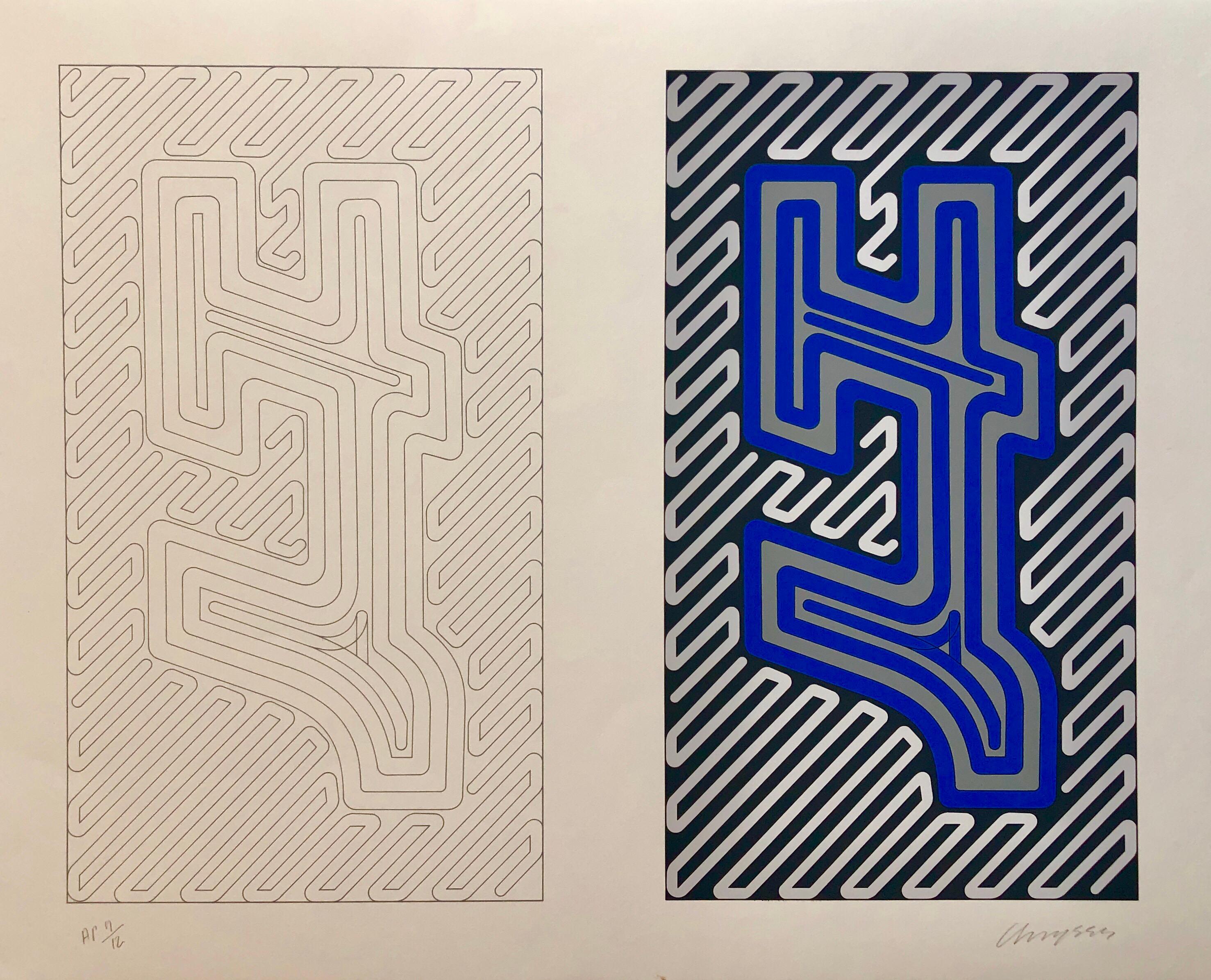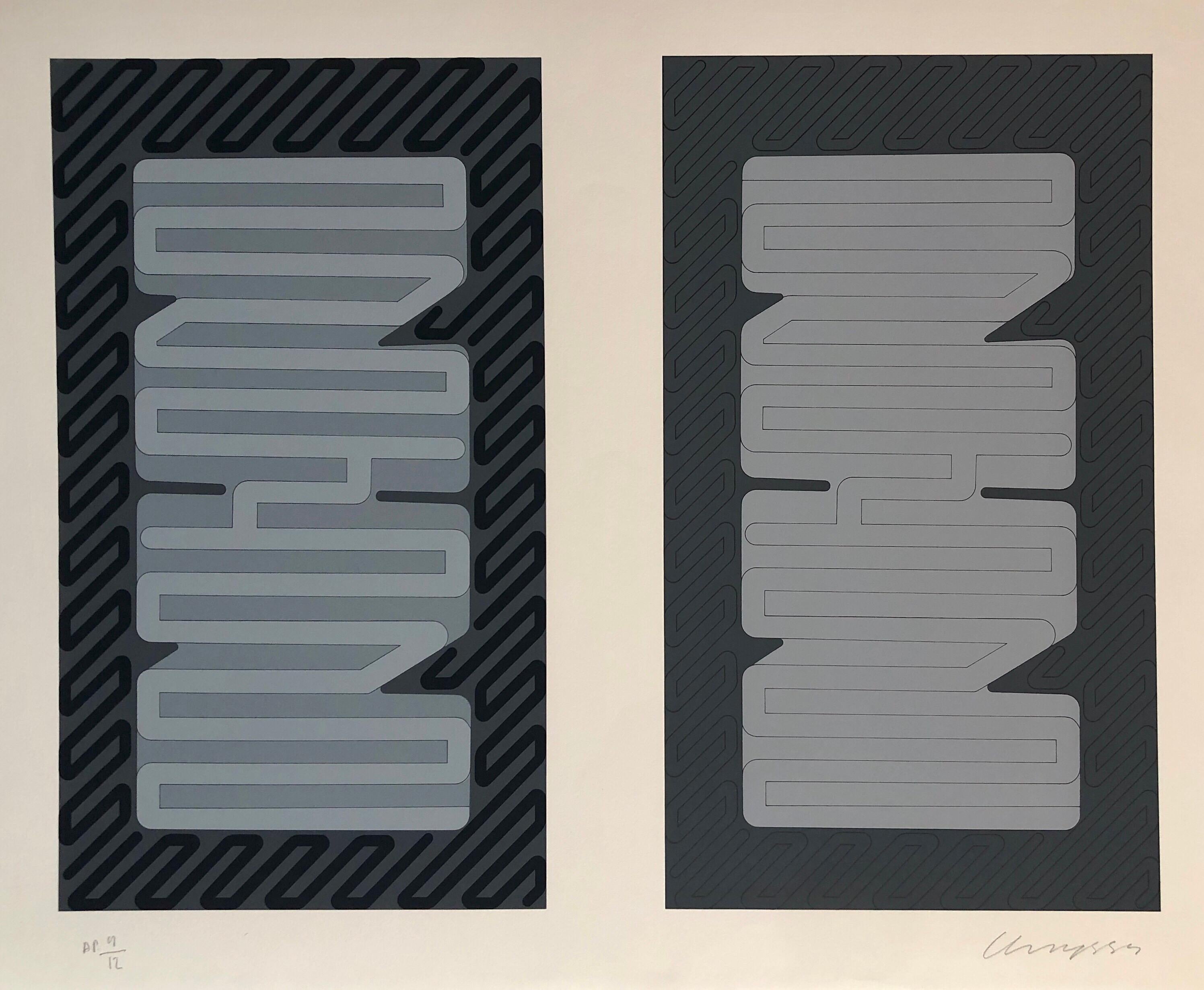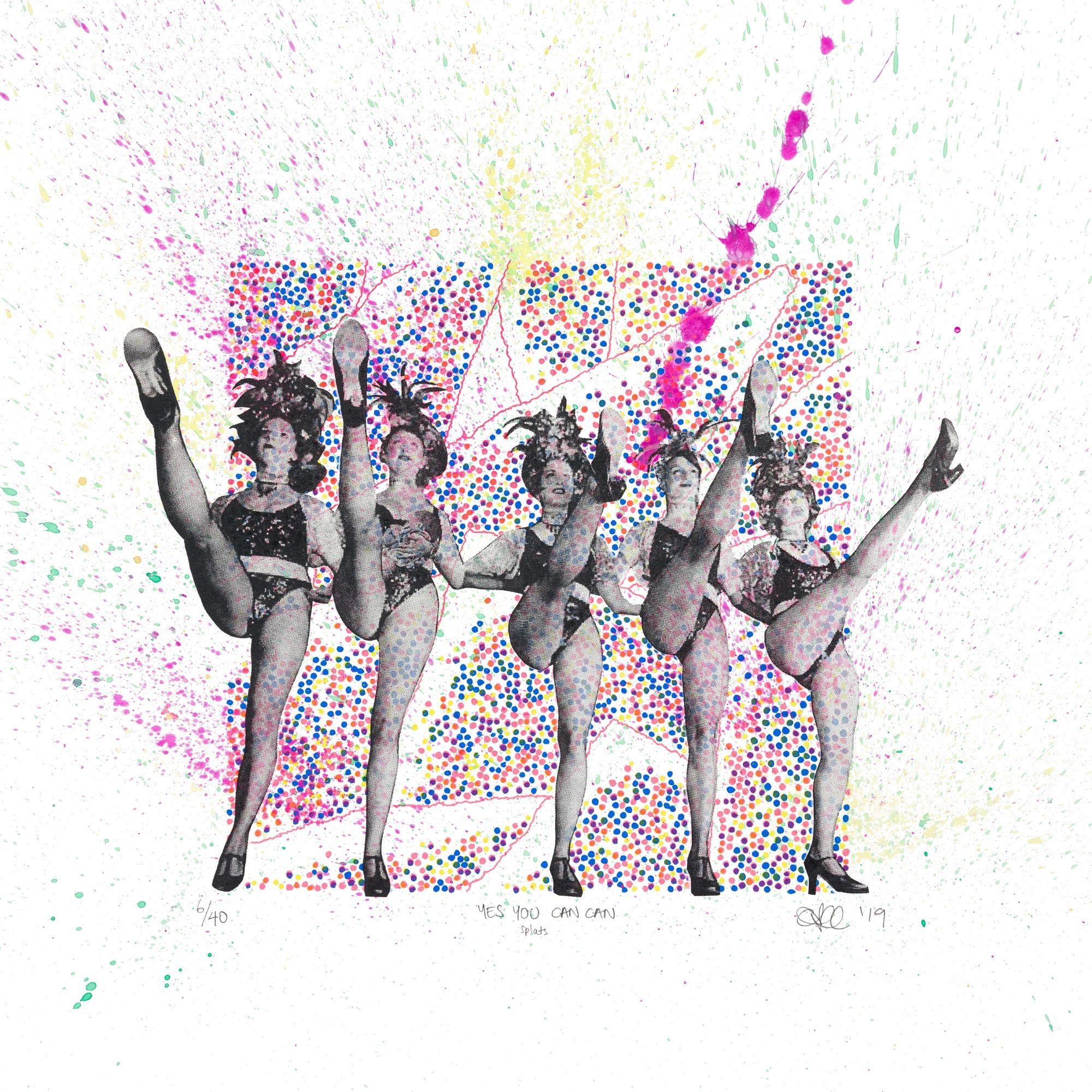Robert IndianaHeptagon1970
1970
About the Item
- Creator:Robert Indiana (1928 - 2018, American)
- Creation Year:1970
- Dimensions:Height: 11.75 in (29.85 cm)Width: 11.75 in (29.85 cm)
- Medium:
- Movement & Style:
- Period:
- Condition:Very good condition.
- Gallery Location:Toronto, CA
- Reference Number:
Robert Indiana
Robert Indiana's work evolved into hard-edged graphic images of words, logos and typographic forms, earning him a reputation as one of the country's leading contemporary artists.
Indiana is known for using public signs and symbols with altered lettering to make stark and challenging visual statements. In his prints, paintings and constructions, he gave new meaning to basic words like Eat, Die and Love. Using them in bold block letters in vivid colors, he enticed his viewers to look at the commonplace from a new perspective. One indication of his success was the appearance of his immensely popular multi-colored Love on a United States postage stamp in 1973.
Find a collection of original Robert Indiana art today on 1stDibs.
- ShippingRetrieving quote...Ships From: Toronto, Canada
- Return PolicyA return for this item may be initiated within 3 days of delivery.
- Untitled (for Kennedy)By Robert RauschenbergLocated in Toronto, OntarioRobert Rauschenberg is revered as one of the most innovative American pop artists - more avant-garde than Warhol, more audacious than Jasper Johns. In addition to his artistic achie...Category
1990s Pop Art More Prints
MaterialsLithograph
- Geometric MouseBy Claes OldenburgLocated in Toronto, OntarioClaes Oldenberg (b.1929) is a Swedish-born American artist, renowned for his contribution to Pop art by way of his iconic soft sculptures and public installations. In 1962, Oldenburg debuted his revolutionary soft sculptures at the Green Gallery in New York. Three giant, squishy sculptures of an ice cream cone, a hamburger, and a slice of cake, swelled across the gallery floor, forever changing the way we define sculpture. It has been noted that Oldenburg's early work was largely inspired by Yayoi Kusama's hand-sewn phallic-shaped soft sculptures that enveloped the surfaces of ironing boards, sofas, and boats. Click here to see an exhibition poster featuring a later example of Kusama's soft sculptures. Ranging from voluminous hamburgers (famously on display at the AGO) to ballistic badminton shuttlecocks, Oldenberg's colossal sculptures replicate commonplace objects on a grand scale, often disrupting the environment they inhibit with curious and playful subtexts. The confrontational nature of Oldenberg's sculptures places an emphasis on the viewer, asking us to reconsider our relationship to these recognizable, but obscure, objects. "Geometric Mouse...Category
1960s Pop Art More Prints
MaterialsLithograph
- Bait (Stoned Moon)By Robert RauschenbergLocated in Toronto, OntarioRobert Rauschenberg is revered as one of the most innovative American pop artists - more avant-garde than Warhol, more audacious than Jasper Johns. In the summer of 1969, Robert Rau...Category
1970s Pop Art More Prints
MaterialsLithograph
- AIDSBy General IdeaLocated in Toronto, OntarioIn 1967, General Idea was founded in Toronto by AA Bronson (b. 1946), Felix Partz (1945-1994), and Jorge Zontal (1944-1994). Over the course of 25 years, they made a significant cont...Category
1980s Conceptual More Prints
MaterialsScreen
- Toronto 20By Jack BushLocated in Toronto, OntarioJack Bush (1909-1977) is known as one of Canada’s most successful abstract artists of the 20th century. In the 1960's he achieved international recognition for his works that positio...Category
1960s Color-Field More Prints
MaterialsScreen
- End of the USABy Jenny HolzerLocated in Toronto, OntarioJenny Holzer is one of the most important and original artists of the 20th century. Her body of work, with an emphasis on text, is consistently provocative and occasionally frightening, manipulating the language of both pop culture and government slogan to produce commentary on global issues notably power structures and warfare. Holzer's iconic "Inflammatory Essays", produced between 1979 and 1982, were first pasted on walls throughout heavily populated metro areas including New York and other cities. Composed of anonymous statements, printed on friendly or calm colored papers, the statements were influenced by writings of major political figures such as Emma Goldman...Category
1980s Conceptual More Prints
MaterialsOffset
- Marilyn Portrait (Red)By Russell YoungLocated in Washington, DCArtist: Russell Young Title: Marilyn Portrait (Red) Portfolio: Marilyn Portrait Medium: Hand-pulled acrylic and enamel silkscreen on paper Date: 2014 Edition: 25/25 Sheet Size: 27" x...Category
2010s Pop Art Portrait Prints
MaterialsEnamel
- 1970's Large Silkscreen Abstract Geometric Day Glo Serigraph Pop Art Print NeonBy Chryssa Vardea-MavromichaliLocated in Surfside, FLSilkscreen on Arches paper, Hand signed and Numbered in Pencil. Serigraph in blue gray (silver). Chryssa Vardea-Mavromichali (Greek: Χρύσα Βαρδέα-Μαυρομιχάλη; December 31, 1933 – December 23, 2013) was a Greek American artist who worked in a wide variety of media. An American art pioneer in light art and luminist sculpture widely known for her neon, steel, aluminum and acrylic glass installations, she has always used the mononym Chryssa professionally. She worked from the mid-1950s in New York City studios and worked since 1992 in the studio she established in Neos Kosmos, Athens, Greece. Chryssa was born in Athens into the famous Mavromichalis family from the Mani Peninsula. one of her sisters, who studied medicine, was a friend of the poet and novelist Nikos Kazantzakis. Chryssa began painting during her teenage years and also studied to be a social worker.In 1953, on the advice of a Greek art critic, her family sent her to Paris to study at the Académie de la Grande Chaumiere where Andre Breton, Edgard Varese, and Max Ernst were among her associates and Alberto Giacometti was a visiting professor. In 1954, at age twenty-one, Chryssa sailed for the United States, arrived in New York and went to San Francisco, California to study at the California School of Fine Arts. Returning to New York in 1955, she became a United States citizen and established a studio in the city. Chryssa's first major work was The Cycladic Books preceded American minimalism by seventeen years. 1961, Chryssa's first solo exhibition was mounted at The Guggenheim. 1963, Chryssa's work was shown at the Museum of Modern Art in curator Dorothy Canning Miller's Americans 1963 exhibition. The artists represented in the show also included Richard Anuszkiewicz, Lee Bontecou, Robert Indiana, Richard Lindner, Marisol, Claes Oldenburg, Ad Reinhardt, James Rosenquist and others. 1966, The Gates to Times Square, regarded as "one of the most important American sculptures of all time" and "a thrilling homage to the living American culture of advertising and mass communications." The work is a 10 ft cube installation of two huge letter 'A's through which visitors may walk into "a gleaming block of stainless steel and Plexiglas that seems to quiver in the play of pale blue neon light" which is controlled by programmed timers. First shown in Manhattan's Pace Gallery, it was given to the Albright-Knox Art Gallery in Buffalo, New York in 1972. 1972, The Whitney Museum of American Art mounted a solo exhibition of works by Chryssa. That's All (early 1970s), the central panel of a triptych related to The Gates of Times Square, was acquired by the Museum of Modern Art between 1975 and 1979. 1973, Chryssa's solo exhibition at the Gallerie Denise René was reviewed for TIME magazine by art critic Robert Hughes before it went on to the Galleries Denise René in Düsseldorf and Paris. Other works by Chryssa in composite honeycomb aluminum and neon in the 1980s and 1990s include Chinatown, Siren, Urban Traffic, and Flapping Birds. Chryssa 60/90 retrospective exhibition in Athens in the Mihalarias Art Center. After her long absence from Greece, a major exhibition including large aluminum sculptures - cityscapes, "neon boxes" from the Gates to the Times Square, paintings, drawings etc. was held in Athens. In 1992, after closing her SoHo studio, which art dealer Leo Castelli had described as "one of the loveliest in the world," Chryssa returned to Greece. She found a derelict cinema which had become a storeroom stacked with abandoned school desks and chairs, behind the old Fix Brewery near the city center in Neos Kosmos, Athens. Using the desks to construct enormous benches, she converted the space into a studio for working on designs and aluminum composite honeycomb sculptures...Category
1980s Pop Art Abstract Prints
MaterialsScreen
- 1970's Large Silkscreen Abstract Geometric Day Glo Serigraph Pop Art Print NeonBy Chryssa Vardea-MavromichaliLocated in Surfside, FLSilkscreen on Arches paper, Hand signed and Numbered in Pencil. Serigraph in white, back, blue gray (silver). Chryssa Vardea-Mavromichali (Greek: Χρύσα Βαρδέα-Μαυρομιχάλη; December 31, 1933 – December 23, 2013) was a Greek American artist who worked in a wide variety of media. An American art pioneer in light art and luminist sculpture widely known for her neon, steel, aluminum and acrylic glass installations, she has always used the mononym Chryssa professionally. She worked from the mid-1950s in New York City studios and worked since 1992 in the studio she established in Neos Kosmos, Athens, Greece. Chryssa was born in Athens into the famous Mavromichalis family from the Mani Peninsula. one of her sisters, who studied medicine, was a friend of the poet and novelist Nikos Kazantzakis. Chryssa began painting during her teenage years and also studied to be a social worker.In 1953, on the advice of a Greek art critic, her family sent her to Paris to study at the Académie de la Grande Chaumiere where Andre Breton, Edgard Varese, and Max Ernst were among her associates and Alberto Giacometti was a visiting professor. In 1954, at age twenty-one, Chryssa sailed for the United States, arrived in New York and went to San Francisco, California to study at the California School of Fine Arts. Returning to New York in 1955, she became a United States citizen and established a studio in the city. Chryssa's first major work was The Cycladic Books preceded American minimalism by seventeen years. 1961, Chryssa's first solo exhibition was mounted at The Guggenheim. 1963, Chryssa's work was shown at the Museum of Modern Art in curator Dorothy Canning Miller's Americans 1963 exhibition. The artists represented in the show also included Richard Anuszkiewicz, Lee Bontecou, Robert Indiana, Richard Lindner, Marisol, Claes Oldenburg, Ad Reinhardt, James Rosenquist and others. 1966, The Gates to Times Square, regarded as "one of the most important American sculptures of all time" and "a thrilling homage to the living American culture of advertising and mass communications." The work is a 10 ft cube installation of two huge letter 'A's through which visitors may walk into "a gleaming block of stainless steel and Plexiglas that seems to quiver in the play of pale blue neon light" which is controlled by programmed timers. First shown in Manhattan's Pace Gallery, it was given to the Albright-Knox Art Gallery in Buffalo, New York in 1972. 1972, The Whitney Museum of American Art mounted a solo exhibition of works by Chryssa. That's All (early 1970s), the central panel of a triptych related to The Gates of Times Square, was acquired by the Museum of Modern Art between 1975 and 1979. 1973, Chryssa's solo exhibition at the Gallerie Denise René was reviewed for TIME magazine by art critic Robert Hughes before it went on to the Galleries Denise René in Düsseldorf and Paris. Other works by Chryssa in composite honeycomb aluminum and neon in the 1980s and 1990s include Chinatown, Siren, Urban Traffic, and Flapping Birds. Chryssa 60/90 retrospective exhibition in Athens in the Mihalarias Art Center. After her long absence from Greece, a major exhibition including large aluminum sculptures - cityscapes, "neon boxes" from the Gates to the Times Square, paintings, drawings etc. was held in Athens. In 1992, after closing her SoHo studio, which art dealer Leo Castelli had described as "one of the loveliest in the world," Chryssa returned to Greece. She found a derelict cinema which had become a storeroom stacked with abandoned school desks and chairs, behind the old Fix Brewery near the city center in Neos Kosmos, Athens. Using the desks to construct enormous benches, she converted the space into a studio for working on designs and aluminum composite honeycomb sculptures...Category
1980s Pop Art Abstract Prints
MaterialsScreen
- 1970's Large Silkscreen Abstract Geometric Day Glo Serigraph Pop Art Print NeonBy Chryssa Vardea-MavromichaliLocated in Surfside, FLSilkscreen on Arches paper, Hand signed and Numbered in Pencil. Serigraph in black, gray (silver). Chryssa Vardea-Mavromichali (Greek: Χρύσα Βαρδέα-Μαυρομιχάλη; December 31, 1933 – December 23, 2013) was a Greek American artist who worked in a wide variety of media. An American art pioneer in light art and luminist sculpture widely known for her neon, steel, aluminum and acrylic glass installations, she has always used the mononym Chryssa professionally. She worked from the mid-1950s in New York City studios and worked since 1992 in the studio she established in Neos Kosmos, Athens, Greece. Chryssa was born in Athens into the famous Mavromichalis family from the Mani Peninsula. one of her sisters, who studied medicine, was a friend of the poet and novelist Nikos Kazantzakis. Chryssa began painting during her teenage years and also studied to be a social worker.In 1953, on the advice of a Greek art critic, her family sent her to Paris to study at the Académie de la Grande Chaumiere where Andre Breton, Edgard Varese, and Max Ernst were among her associates and Alberto Giacometti was a visiting professor. In 1954, at age twenty-one, Chryssa sailed for the United States, arrived in New York and went to San Francisco, California to study at the California School of Fine Arts. Returning to New York in 1955, she became a United States citizen and established a studio in the city. Chryssa's first major work was The Cycladic Books preceded American minimalism by seventeen years. 1961, Chryssa's first solo exhibition was mounted at The Guggenheim. 1963, Chryssa's work was shown at the Museum of Modern Art in curator Dorothy Canning Miller's Americans 1963 exhibition. The artists represented in the show also included Richard Anuszkiewicz, Lee Bontecou, Robert Indiana, Richard Lindner, Marisol, Claes Oldenburg, Ad Reinhardt, James Rosenquist and others. 1966, The Gates to Times Square, regarded as "one of the most important American sculptures of all time" and "a thrilling homage to the living American culture of advertising and mass communications." The work is a 10 ft cube installation of two huge letter 'A's through which visitors may walk into "a gleaming block of stainless steel and Plexiglas that seems to quiver in the play of pale blue neon light" which is controlled by programmed timers. First shown in Manhattan's Pace Gallery, it was given to the Albright-Knox Art Gallery in Buffalo, New York in 1972. 1972, The Whitney Museum of American Art mounted a solo exhibition of works by Chryssa. That's All (early 1970s), the central panel of a triptych related to The Gates of Times Square, was acquired by the Museum of Modern Art between 1975 and 1979. 1973, Chryssa's solo exhibition at the Gallerie Denise René was reviewed for TIME magazine by art critic Robert Hughes before it went on to the Galleries Denise René in Düsseldorf and Paris. Other works by Chryssa in composite honeycomb aluminum and neon in the 1980s and 1990s include Chinatown, Siren, Urban Traffic, and Flapping Birds. Chryssa 60/90 retrospective exhibition in Athens in the Mihalarias Art Center. After her long absence from Greece, a major exhibition including large aluminum sculptures - cityscapes, "neon boxes" from the Gates to the Times Square, paintings, drawings etc. was held in Athens. In 1992, after closing her SoHo studio, which art dealer Leo Castelli had described as "one of the loveliest in the world," Chryssa returned to Greece. She found a derelict cinema which had become a storeroom stacked with abandoned school desks and chairs, behind the old Fix Brewery near the city center in Neos Kosmos, Athens. Using the desks to construct enormous benches, she converted the space into a studio for working on designs and aluminum composite honeycomb sculptures...Category
1980s Pop Art Abstract Prints
MaterialsScreen
- Growing IBy Keith HaringLocated in Hollywood, FLArtist: Keith Haring Title: Growing I Size: 40 1/8 x 29 7/8 in. (101.9 x 75.9 cm) Medium: Screenprint in colors, on Lenox Museum Board, with full margins. Edition: 85 of 100 Year:...Category
1980s Pop Art More Prints
MaterialsScreen
- Yes You Can CanLocated in Deddington, GBYes You Can Can (Splats Edition) by Amy Gardner [2020] limited_edition Screen Print, Watercolour Edition number 40 Image size: H:50 cm x W:50 cm Sold Unframed Please note that insitu images are purely an indication of how a piece may look Only AP works left in this edition. This print is about women supporting women. 'YES YOU CAN CAN' splats edition limited edition of 40 Archival Bread & Butter bright white paper 270gsm 50x 50cms 5 screen...Category
21st Century and Contemporary Pop Art Figurative Prints
MaterialsPaper, Watercolor, Screen






